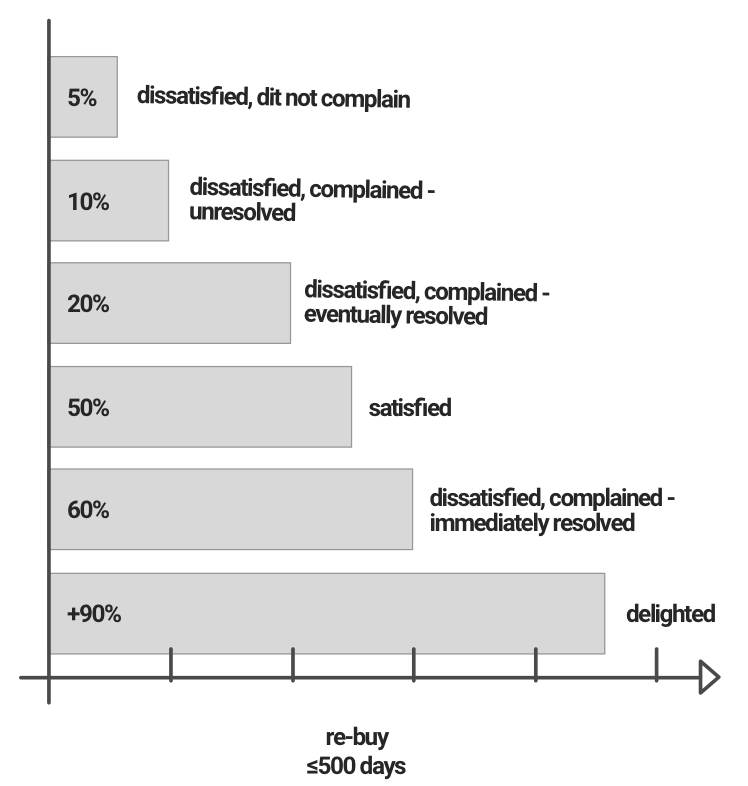Customer loyalty is good business
“a customer who has a problem, calls about it, and gets good service can end up being more loyal than a customer who never experiences a problem in the first place”
Those were my approximate words in an article about the ROI of user understanding that I wrote two years ago. The claim was – and is – based, not just on my own fairly extensive experience from the retail field, but also on substantial insights and experiences from the field in general, and in other areas as well. I didn’t bring out any numbers on this at the time, though.
They do exist, however, and today, dear interested reader, we’ll look at them together.
That figure there is reproduced afterJohn Branch of Michigan Ross University, who has conducted academic studies on the subject of “customer loyalty”. That’s the hard numbers to back my claim: – good service after a problem is a whole 10 percentage points better than simply being satisfied. or 20% better, in a direct comparison between the two.

There are a few things to take note of here. The first, of course, being that good customer service can be a better driver for loyalty than basic customer satisfaction!
This is something most people find it intuitively hard to understand – but it isn’t so strange once you take a closer look. Basic satisfaction is characterized by low emotional intensity; in fact, many experiences are satisfying specifically because we don’t really notice them. They don’t throw up any “flags”, and do not establish themselves explicitly (until you think about it a bit). Getting help, on the other hand, is an experience which attracts attention to itself and sticks in the mind – and since we human beings are fundamentally social, getting help is a significant emotional marker in itself. I don’t have any figures but I talked a bit with prof. Branch about it, and we agree that the emotional response is probably even stronger if the help is experienced as coming from an actual person – which has to do with another characteristic of good customer service: A lot of any complaint isn’t as much about having the issue fixed as it is about being listened to and feeling validated. Being treated like a live person, basically.

why is it that when you google “satisfied” there’s a bunch of pictures of cats…?
That’s why we see the re-buy rate go up with people who’ve complained, even if the complaint was unresolved. Just “getting it off our chest” makes us feel better. But, just listening isn’t quite enough, which we can see in the significant difference between the “problem solved eventually” and “problem solved immediately” rates. Seeing the complainee act right away makes a big difference.
Another thing worth noting is that satisfied customers do tend to come back. The old shop-keeper adage is “the satisfied customer will come back” (I’ve referenced that version myself) – that turns out to not be entirely true, but the satisfied customer will often return. Once more it has to do with what things mean: As mentioned before, basic satisfaction is a low-intensity emotion – and that’s because in this context, satisfaction basically means that you’ve lived up to your own promise.
Any business engenders a promise; if you’ve opened a grocery store you’re promising a reasonable selection of daily goods, if you’ve launched a driver’s ed you promise to teach people to drive, if you’re a bank you’re promising to ward people’s money etc. Satisfying your customer means living up to that, so it’s understandable, from her point of view, that accomplishing it is, well, not super-much of an accomplishment. It’s enough to raise the likelihood of her coming back but it isn’t remarkable, like seeing you go out of your way to fix a problem is – the kind of response that makes your customer think “they didn’t have to do that” is what brings that return rate up close to 100%.
This doesn’t mean every customer expectation is the same or is reasonable, of course – but it explains why satisfaction alone is pretty undramatic.
It also highlights the seriousness of the problem if, as a business, you don’t have satisfied customers – you simply aren’t holding up your end of the bargain.
Finally, of course, there’s delight. The delighted customer. What does that mean? Well, we grazed it in the above: Delighting your customer requires you to exceed the expectations you yourself has set. To go above and beyond. Make an effort for the sake of customer’s wellbeing. And, as we also see, present your customer with a human face, and treat her like a human being, too – not just when things go pear-shaped, or when you’re sealing a deal, but always. Unfortunately, to many businesses the “service” area is often about how little you can get away with, how cheaply you can do it, outsourcing etc. But we know that, statistically, a loyal customer is worth about ten times her initial purchase. And we know that it’s on the order of 4-6 times (some sources say up to 10X) as expensive to make a sale to a new customer, compared to an existing one.
Most businesses simply can’t afford to skimp on the customer experience.





